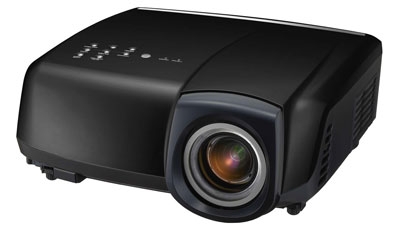Mitsubishi HC4900 1080p LCD Front Projector Page 2

| The Short Form |
| Price $3,000 / mitsubishi-hometheater.com / 888-307-0349 |
| Snapshot |
| Mitsubishi's impressive, affordable LCD gives good reason to switch from rear to front projection. |
| Plus |
| •Very good out-of-box color •Crisp high-def picture •Displays deep-black shadows with Auto Iris feature enabled •Flexible, wide-ranging setup options |
| Minus |
| •Picture can lack punch with Low lamp mode selected •Limited aspect-ratio options for high-def |
| Key Features |
| •1,920 x 1,080-pixel LCD display •1.6x Zoom lens; 1.41-2.26 throw ratio •Motorized Zoom, Focus, and Horizontal/Vertical lens shift •Inputs: HDMI; DVI; component-, composite-, and S-video; VGA; RS-232C •17.9 x 6.9 x 16.5 in; 25.5 lb |
| Test Bench |
| With the User mode and Medium color temperature selected, the HC4900's grayscale tracked within ±362 K of the 6,500-K standard from 20 to 100 IRE - very good performance. Adjustments improved this further, to ±113 K. Color-decoder tests showed no error on the HDMI and component-video inputs. Red, green, and blue primary-color points all displayed a degree of over-saturation - a common finding in our front-projector tests. Overscan for both HDMI and component-video inputs measured 0% for 1080i/p signals with the projector set to minimum overscan. And the HC4900 fully and cleanly resolved 1080i/p test patterns via both connections. The Mitsubishi was able to accept a 1080p/24-format signal from both a signal generator and a Sony Blu-ray Disc player, although it displays the format at a standard 60-Hz refresh rate. Screen uniformity was excellent, with no sign of tinting or uneven brightness visible on gray full-field test patterns. The projector's post-calibration brightness proved mostly adequate for dark-room viewing on a 100-inch-diagonal screen. Turning on the High lamp mode yielded much better brightness but also an audible boost in fan noise. The best-case full-on/off contrast ratio I measured was 1,840:1 with the Standard lamp and Auto Iris 2 modes selected - respectable compared with other 1080p LCD projectors tested recently. Full Lab Results |
Setup I positioned the Mitsubishi about 13 feet away from an 87-inch-wide (100-inch-diagonal) Stewart Filmscreen FireHawk SST screen. (With that particular size, the projector's 1.6x zoom lens allows for placement anywhere between 10 and 16.5 feet away.) The HC4900's Zoom and Focus controls are motorized adjustments that can be operated via the remote. The same thing goes for its Lens Shift adjustment, which provides up to 5% horizontal and 75% vertical offset in either direction. This flexible feature array is mighty impressive for a budget projector.
The HC4900 also has two lamp options: the near-silent Low setting and the Standard setting, which boosts brightness but increases fan noise considerably while decreasing lamp life from a healthy 5,000 hours to 2,000 hours. I went with the Low setting - the Lamp mode that I choose on most projectors - and then selected the projector's Auto Gamma, Medium color temperature, and Auto Iris 1 modes. Three separate picture memories are available for each input. As it turned out, the Mitsubishi's Medium color-temperature preset delivered an almost dead-on 6,500-K grayscale from the get-go - very welcome indeed.
Performance Getting a good black level with LCD projectors could be a problem in the past - a big problem. But the iris controls on many new models go a long way toward addressing that shortcoming. When I watched a Blu-ray Disc of Pirates of the Caribbean: Dead Man's Chest with the Mitsubishi's Auto Iris modes engaged, for instance, it did a great job delivering deep, inky blacks in a shipboard scene where Jack Sparrow (Johnny Depp) addresses his fellow pirates after emerging from a floating casket. (Overall, I got the best picture contrast from the projector with the Auto Iris 2 setting. Blacks looked a hair deeper than with the other two Iris presets.) Shadow detail was also very good for an LCD: I could easily make out a range of dark gray tones in the ragged cloaks of the figures gathered on deck. And even though the HC4900 sometimes seemed a bit strained when it came to light output with the Low lamp option selected, I was impressed at how crisp and punchy the white shirt worn by Gibbs (Kevin McNally) looked in this mostly murky scene.
The HC4900's picture detail was also excellent via both its HDMI and component-video inputs. During a scene where a British commander pours Will Turner (Orlando Bloom) a snifter of brandy, I could see finely etched textures on the surface of the ornate glass. And in a subsequent scene where the drunken Sparrow tries to plot a course on a map, the thin lines covering its surface looked completely solid - an effect that helped make the picture pop.
- Log in or register to post comments




















































